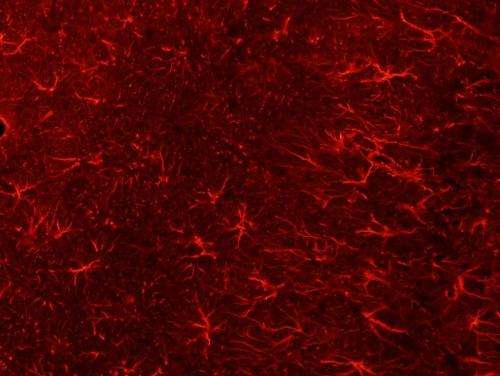This article has been reviewed according to Science X's editorial process and policies. Editors have highlighted the following attributes while ensuring the content's credibility:
fact-checked
peer-reviewed publication
trusted source
proofread
Trading sickness for health: Swapping brain cells points to new Huntington's therapies

New research appearing in the journal Nature Biotechnology answers important questions about the viability of treatments that seek to replace diseased and aged cells in the central nervous system with healthy ones. Its findings have implications for a number of neurological and psychiatric disorders—including Huntington's disease, amyotrophic lateral sclerosis (ALS), and schizophrenia—that have been linked to glia, a population of cells that support brain health and function.
"A broad variety of disorders we associate with neuronal loss now appear to be caused by dysfunctional glial cells," said University of Rochester Medical Center (URMC) professor of Neurology Steve Goldman, MD, Ph.D., lead author of the new study. "This makes these diseases attractive targets for stem and progenitor cell-based therapies."
The new study from the URMC Center for Translational Neuromedicine, which Goldman co-directs, describes the ability of human glial progenitor cells—precursor cells that can give rise to both astrocytes and oligodendrocytes, the two major types of glia—to compete with one another in the adult brain, and the competitive advantage of young and healthy cells over aged and diseased cells.
The culmination of a decade of scientific progress
A number of recent important advances are behind the new findings. In 2013, Goldman and colleagues first reported strategies for producing the brain's glial support cells from embryonic stem cells.
In later research, the lab transplanted these cells into the brains of baby mice, resulting in the creation of human glial-chimeric mice, a technical achievement that enables the researchers to study human glial cells in the living brain. The team showed that after transplantation, the human glial progenitor cells quickly outcompeted native cells, resulting in brains with mouse neurons and human glia.
In later experiments, the lab transplanted human glial cells with the Huntington's disease (HTT) mutation. They observed that this mutation impaired the function of glial progenitor cells, resulting in poor astrocytes and oligodendrocytes production. The lab also showed that transplanting healthy human glial progenitor cells into mouse models of Huntington's delayed disease progression, reinforcing the importance role that glial dysfunction plays in this still untreatable neurodegenerative disease.
Young and healthy cells out-compete older and sick ones
As these prior studies were limited to the transplant of human cells into the mouse brain, the question remained whether human cells transplanted into another human brain would yield the same type of benefit. This new study strongly suggests that the answer to this question is yes, and highlights the potential value of cell replacement therapies by showing that healthy human glia will out-compete and replace sick human cells.
To demonstrate this, the researchers first implanted human glial progenitor cells with the HTT mutation into the brains of newborn mice. After the animals reached adulthood, the researchers then transplanted healthy human glial cells, which went on to displace and eliminate their Huntington's disease counterparts.
"In the striatum, our target area, the healthy cells essentially kicked out the disease cells, eventually replacing the glial progenitor population entirely," said Goldman. "You can actually see a wave of migration and a border where the cells expressing the HTT mutation are dying off and being replaced by heathy ones."
In an accompanying set of experiments, the researchers found that younger healthy human glial progenitors outcompeted older and otherwise healthy human glia, suggesting that cellular youth is a critical determinant of competitive success.
"These findings have strong therapeutic implications, as they suggest that in the adult human brain, resident glia—whether diseased or simply aged—may be replaced following the introduction of younger and healthier cells," said Goldman.
Additional authors of the study include John Mariani, Renee Solly, Ashley Tate, Steven Schanz, Natasha Cotrupi, and Abdellatif Benraiss with URMC, and Ricardo Vieira, Gwen Huynh, Hans Stephensen, Marzieh Mousaei, and Jon Sporring with the University of Copenhagen.
More information: Young glial progenitor cells competitively replace aged and diseased human glia in the adult chimeric mouse brain, Nature Biotechnology (2023). DOI: 10.1038/s41587-023-01798-5



















